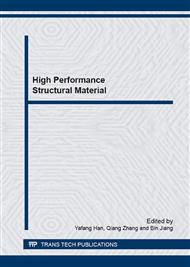[1]
Miehe, C., Schotte, J., Lambrecht, M.: J. Mech. Phys. Solids Vol. 50 (2002), p.2123.
Google Scholar
[2]
Homayonifar, M., Mosler, J.: Int. J. Plast. Vol. 28 (2012), p.1.
Google Scholar
[3]
K. Zhang, B. Holmedal, O.S. Hopperstad, S. Dumoulin, J. Gawad, A. Van Bael and P. Van Houtte: Int. J. Plast. (2014), in press.
Google Scholar
[4]
Nebebe, M., Bohlen, J., Steglich, D., Letzig, D.: Int. J. Mater. Form. Vol. 2 (2009), p.53.
Google Scholar
[5]
Steglich, D. et al. : Int. J. Mater. Form. Vol. 4 (2011), p.243.
Google Scholar
[6]
Yi, S. et al. : Acta Mater. Vol. 58 (2009), p.592.
Google Scholar
[7]
Hill, R. : Proc. R. Soc. Vol. 193 (1948), p.281.
Google Scholar
[8]
Agnew, S. R., Duygulu O.: Int. J. Plast. Vol. 21 (2005), p.1161.
Google Scholar
[9]
Agnew, S. R., Yoo, M. H., Tome C. N.: Acta Mater. Vol. 49 (2001), p.4277.
Google Scholar
[10]
Cazacu, O., Barlat, F.: Int. J. Plast. Vol. 20 (2004), p. (2027).
Google Scholar
[11]
Cazacu, O., Plunkett, B., Barlat, F.: Int. J. Plast. Vol. 22 (2006), p.1171.
Google Scholar
[12]
Shi, B., Mosler, J.: Int. J. Plast. Vol. 44 (2013), p.1.
Google Scholar
[13]
Haddadi, H., Bouvier, S., Banu, M., Maier, C., Teodosiu, C.: Int. J. Plast. Vol. 22 (2006), p.2226.
Google Scholar
[14]
Hiwatashi, S., Bael, A., Houtte, P., Teodosiu, C.: Int. J. Plast. Vol. 14 (1998), p.647.
Google Scholar
[15]
Noman, M., Clausmeyer, T., Barthel, C., Svendsen, B., Huetink, J., Riel, M.: Mater. Sci. Eng. A Vol. 527(2010), p.2515.
Google Scholar
[16]
Feigenbaum, H., Ph.D. thesis, (2008), University of California Davis.
Google Scholar
[17]
Feigenbaum, H., Dafalias, Y.: Int. J. Solids Struct. Vol. 44 (2007), p.7526.
Google Scholar
[18]
Ishikawa, H.: Int. J. Plast. Vol. 13 (1997), p.533.
Google Scholar
[19]
Herrera-Solaz, V., LLorca, J., Dogan, E., Karaman, I., Segurado, J.: Int. J. Plast. (2014), in press.
Google Scholar
[20]
Lee, E.: J. Appl. Mech. Vol. 36 (1969), p.1.
Google Scholar
[21]
Coleman, B., Gurtin, M.: J. Chem. Phys. Vol. 47 (1967), p.597.
Google Scholar
[22]
Mandel, J.: Plasticite classique et viscoplasticitite. (1971) CISM.
Google Scholar
[23]
Lemaitre, J.: J. Eng. Mat. Techn. Vol. 107 (1985), p.83.
Google Scholar
[24]
Yi, S. B., Davies, Ch. H. J.: Acta Mater., Vol. 54 (2006), p.549.
Google Scholar
[25]
Choi, S. H. Shin, E. J., Seong, B. S.: Acta Mater., Vol. 55 (2007), p.4181.
Google Scholar
[26]
Yin, D. L., Wang, J. T., Liu, J. Q., Zhao, X.: J. Alloys Compd., Vol. 478 (2009), p.789.
Google Scholar


